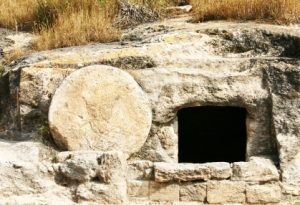Jesus’ Resurrection – Scriptural Evidence

What scriptural evidence do we have about the resurrection of Jesus? What did people living in the first century think about reports of Jesus’ death and resurrection? Are there clues in the Bible as to whether the story is true or not? Let’s examine some Bible verses to find out.
Matthew 27:57-60; Mark 15:42-46; Luke 23:54-60; John 19:38-42– Joseph of Arimathea and Nicodemus, prominent members of the Jewish ruling council, would have been well known in Jerusalem, as well as to Pilate. This could not be fiction, since this could easily be refuted, if false.
John 19:39,40 – Spices – 75 lbs – a very large amount, such as used in royal burials.
Matthew 27:57-60 – Buried just before the Sabbath, or evening. Big stone in front of the tomb. Jews rested on the Sabbath.
Matthew 27:62-66 – “The chief priests and the Pharisees went to Pilate . . . ‘Take a guard,’ Pilate answered, ‘Go, make the tombs as secure as you know how.’ So they went and made the tomb secure by putting a seal on the stone and posting the guard” (NIV). The tomb was sealed with a wax seal with rope. If Jesus’ body had not been there, these Jewish leaders would have certainly reported this to Pilate, so it obviously was there at this point. To break the seal was punishable by death. The tomb was guarded by a group of soldiers. Jews would not have wanted to steal his body. The Romans didn’t care. Pilate’s job was to keep things calm and quiet. Did the disciples steal Jesus’ body? They were disillusioned, discouraged, and depressed. They would have had to overpower the guards. They had scattered at Jesus’ arrest. (Mark 14:50) Peter denied even knowing Jesus. (Mark 14:66) He went back to fishing, etc. (John 21:3)
Luke 24:10,11 – The resurrection seemed like nonsense to Jesus’ disciples. They did not accept the woman’s testimony. But her account was not made up – women were the first eyewitnesses.
John 20:9,10 – The disciples still did not understand Bible prophecies about Jesus’ resurrection. The story was obviously not made to fit a preconceived understanding of scriptural prophecy.
John 20:6,7 – Linen wrappings were left behind as if Jesus’ body had simply vacated them. The cloth that covered Jesus’ head was still rolled up in the shape of a head (NASB), about the right distance from the wrappings that enveloped his body. Grave robber(s) couldn’t possibly have made off with Jesus’ body and left the linens as if they were still shaped around it. Such costly garments would have been stolen in a robbery. Jesus’ resurrection into a spiritual body meant he could and did come to life without having any need of his fleshly body. (1 Peter 3:18; 1 Corinthians 15:44,45,50; Luke 24:31,36; John 20:19,26 NIV p. 1754 [Lk 24:21])
Acts 2:41-46; 3:24-26; 4:10-12, 19,20; 5:26-42; 6:8-14 – They changed their religion – very dangerous.
Matthew 28:11-15 – When faced with Jesus’ obvious resurrection, religious leaders tried to cover it up with a lie. The empty tomb presented a huge problem for the Jewish religious leaders, who resorted to very underhanded tactics in their desperate attempt deny the fact of the resurrection.
Acts 2:29-36 – David died, was buried in his tomb, and his remains are still there for anyone’s inspection. Jesus died, was buried, but his body is missing. Anyone in the audience could have refuted this, if false. Audience included – skeptics. (Acts 2:14-15) The tomb could have been opened and the body paraded throughout the city to show everyone Jesus’ message was false. All Jerusalem had heard the news, including hundreds of thousands of visitors. (Luke 24:14-18) The story could have easily been falsified or verified. Jews from all over the Roman empire now knew about his death.
1 Cor 15:3-8 – Many saw Jesus after his resurrection. Witnesses could have been interviewed, even decades later. The event happened in a major city, not some remote location. And the death, burial, and resurrection took place “according to the scriptures.”
Acts 3:15-16; Acts 4:7; Acts 4:16-18; Acts 4:21; Acts 5:27-33 – The resurrection presented a big problem for religious leaders.
Acts 6:8-10 – Jews (possibly including Saul) argued against teaching about Jesus, but could not refute it.
Luke 24:14-18; John 19:19,20 – The Romans conducted crucifixions at major public crossroads to make an example of the victims and warn others. It was customary for the Roman soldiers to provide a written public notice of the criminals’ name and crimes. This sign was one of Pilate’s final acts of revenge against the Jewish high council. It was written in three languages for the whole world to understand:
- Hebrew – for native Jews
- Greek – for foreigners and visiting Jews (it was the international language of communication at that time)
- Latin – for Romans, lingua franca
As we can see from these verses, Jesus was very well-known in the first century. Reports of his death, as well as his resurrection, were widespread. The evidence was there, and opposers were not able to refute it. And the evidence points to the fact that Jesus died, was buried, and rose again “according to the scriptures.”